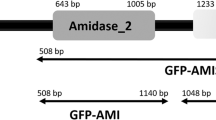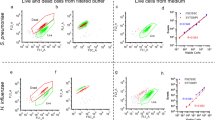Abstract
Methicillin-resistant Staphylococcus aureus (MRSA) and methicillin-susceptible S. aureus (MSSA) can be reliably differentiated by flow cytometry when labeled with nucleic acid dyes. The purpose of this study was to determine if this differentiation can be achieved while labeling with a S. aureus-specific anti-staphylococcal protein A antibody instead of nucleic acid dyes. A total of 103 S. aureus isolates were incubated for 4 h at 37°C in Mueller Hinton broth with and without oxacillin, then stained with anti-staphylococcal protein A antibody, and analyzed by flow cytometry using the Micro PRO™ instrument. Dot plots (side scatter vs. fluorescence intensity) of isolates exposed to oxacillin were examined to define two gates encompassing the majority of MSSA and MRSA signal events, respectively. The ratio of signal event counts in the two gates was called the gate signal count ratio (GSCR), and its performance was evaluated using receiver operating characteristic (ROC) curves. The GSCR could differentiate MRSA from MSSA with 98% sensitivity and 100% specificity using a cut-off of 0.6868 when the two gates were defined as follows: gate 1, fluorescence intensity 2–10, side scatter 5–70; gate 2, fluorescence intensity 7–700, side scatter 70–500. MRSA and MSSA can be accurately detected and differentiated by flow cytometry after 4 h of oxacillin exposure when labeled with anti-staphylococcal protein A antibody.


Similar content being viewed by others
References
Shrestha NK, Scalera NM, Wilson DA, Procop GW (2011) Rapid differentiation of methicillin-resistant and methicillin-susceptible Staphylococcus aureus by flow cytometry after brief antibiotic exposure. J Clin Microbiol 49:2116–2120
Shrestha NK, Scalera NM, Wilson DA, Brehm-Stecher B, Procop GW (2011) Rapid identification of Staphylococcus aureus and methicillin resistance by flow cytometry using a peptide nucleic acid probe. J Clin Microbiol 49:3383–3385
Wilson DA, Molitor K, Oppendahl A, Procop GW (2009) The detection of Staphylococcus aureus by protein A immuno-flow cytometry. In: Proceedings of the 109th General Meeting of the American Society for Microbiology, Philadelphia, PA, May 2009
Clinical Laboratory Standards Institute (CLSI) (2006) Methods for dilution antimicrobial susceptibility tests for bacteria that grow aerobically. Approved standard M7-A6. CLSI, Wayne, PA
Thornsberry C, McDougal LK (1983) Successful use of broth microdilution in susceptibility tests for methicillin-resistant (heteroresistant) staphylococci. J Clin Microbiol 18:1084–1091
Acknowledgments
This study was partially supported by Advanced Analytical Technologies, Inc., Ames, IA, USA.
Conflicts of interest
Angie Oppedahl is an employee of Advanced Analytical Technologies, Inc. All the other authors have no conflicts.
Author information
Authors and Affiliations
Corresponding author
Rights and permissions
About this article
Cite this article
Shrestha, N.K., Wilson, D.A., Scalera, N.M. et al. Immuno-flow cytometry for the rapid identification of Staphylococcus aureus and the detection of methicillin resistance. Eur J Clin Microbiol Infect Dis 31, 1879–1882 (2012). https://doi.org/10.1007/s10096-011-1514-5
Received:
Accepted:
Published:
Issue Date:
DOI: https://doi.org/10.1007/s10096-011-1514-5




